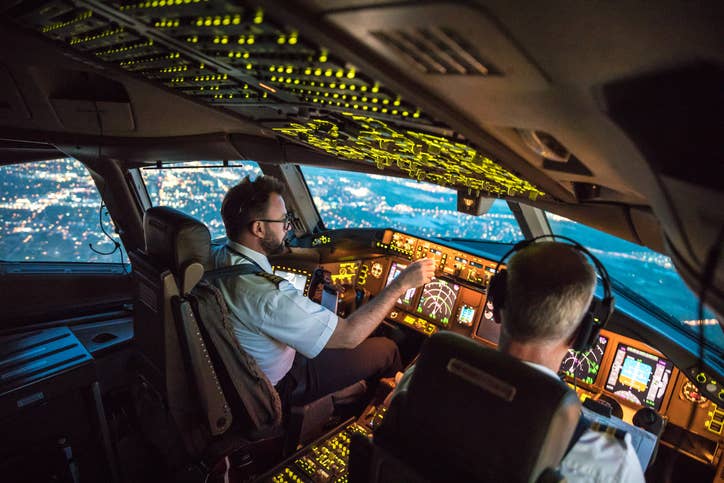
Are you a hopeful pilot wondering whether or not professional pilots can wear glasses? If so, this post is for you. [Credit: iStock]
Becoming a pilot is a dream job for lots of individuals, but having an inaccurate understanding of the job’s prerequisites can often prevent people from ever pursuing it seriously. Vision requirements for pilots are one of the many things that the general public tends to be unclear on when it comes to the world of aviation. There are lots of misconceptions about being a pilot, and one of the biggest is that perfect eyesight is a requirement. Is it a myth or fact that pilots need perfect vision? Read below.
Do I Need Perfect Vision to Be a Pilot?
Although pilots aren’t required to naturally have 20/20 vision, they are required to correct their vision using corrective contact lenses or eyeglasses. Taking that into consideration, there are certain sight requirements that different agencies require of their pilots. For example, while natural 20/20 vision may not be completely necessary to fulfill FAA vision requirements, different agencies may require a minimum natural eyesight threshold, in order for you to work for them as a pilot. . More details on vision requirements for pilots include:
What Are the FAA Standards for Vision?
FAA vision requirements for pilots state that distance vision should be 20/20 or better naturally, or by using corrective contact lenses or glasses. When it comes to near vision, FAA vision requirements state that pilots should possess 20/40 vision in each eye when viewing something that’s 16 inches away. The requirement increases to 32 inches away for pilots older than 50.
Why Do Pilots Need 20/20 Vision?
There are a couple of key reasons why pilots are required to have 20/20 vision. The first is due to the fact that routine flying procedures like takeoffs and landings could result in crashes without the ability to see other aircrafts in the distance. Pilots are also required to have 20/20 vision because dealing with resources like charts and maps that pilots rely on for navigation purposes could be difficult or impossible without 20/20 vision both near and far.
Can People Who Wear Glasses Be Air Force Pilots?
Vision requirements for pilots in the Air Force are a bit more complex. People who wear glasses can be Air Force pilots, but they are required to have 20/30 nearsighted vision without correction. The farsighted vision requirements for pilots in the Air Force is 20/70, which can be corrected to 20/20 with contact lenses or glasses.
Do You Need 20/20 Vision to Be a Military Pilot?
Vision requirements for pilots in the military, in general, aren’t as strict as they are for the Air Force specifically. In order to become a pilot within the Department of the Navy, pilots need at least 20/40 vision. Vision requirements for pilots in the Army are at least 20/50 eyesight, but they, like the Navy, allow pilots to correct their vision using glasses, contact lenses or Lasik.
Do You Need 20/20 Vision to Be a Helicopter Pilot?
The vision requirements for pilots who fly helicopters is 20/20 vision. If you don’t naturally have 20/20 vision, you can correct your eyesight accordingly using corrective eyewear.
Pilot Vision Requirements by Certificate Type
Another differentiating factor among vision requirements for pilots is the type of pilot certificate they have. The vision requirements by certificate are as follows:
Commercial Pilot and Airline Transport Pilot Certificates
A second-class medical certificate is required for receiving a commercial pilot certificate. To attain medical approval, a pilot must have vision that’s correctable to 20/20 for farsighted vision and 20/40 for nearsighted vision at 16 inches away. For those who are 50 years or older, the vision requirements for intermediate vision needs to be correctable to 20/40 while viewing something that’s 32 inches away.
Private Pilot Certificate
In order to get a private pilot certificate, pilots must obtain their third-class medical certificate. The vision requirements for pilots hoping to obtain a third-class medical certificate is nearsighted and farsighted vision that can be corrected to 20/40.
How to Get More Details About Vision Requirements for Pilots
Misconceptions like perfect eyesight being mandatory for professional pilots can be hard to clear up without having a reliable source for aviation information. FLYING Magazine is one of the most reputable sources available for uncovering the insights that aviation professionals and enthusiasts alike are constantly seeking. Subscribe to FLYING Magazine today.

Sign-up for newsletters & special offers!
Get the latest FLYING stories & special offers delivered directly to your inbox






